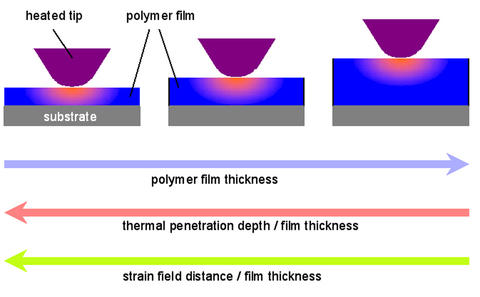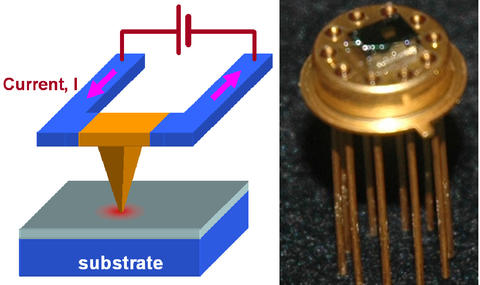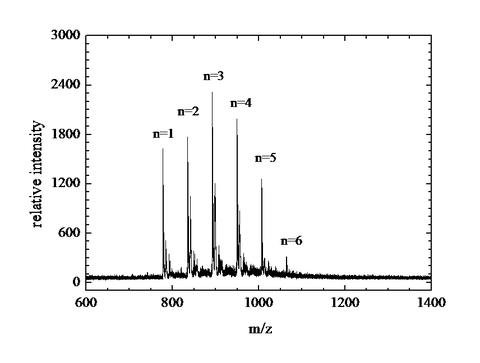Summary
Our goal is to develop measurement techniques to characterize the changes in thermal transport and thermal transition temperatures in polymeric and hybrid materials induced by nanoscale confinement and interfaces with dissimilar materials. The ability to measure and model these properties at the nanoscale is needed by industry to develop thermal management solutions for next-generation semiconductor electronic and other active nanodevices.
Description

|
It is known that at the nanoscale, composition and interface structure play important roles in determining the mechanical, thermal, and electrical properties of multiphase nanomaterials and nanocomposites. To probe the thermal properties of these heterogeneous nanomaterials, local thermal analysis with nanometer resolution is needed. To this end, we are advancing nano-thermomechanometry by exploiting a scanned probe microscopy heating tip method based on batch-processed silicon tips. |
 |
Complementing this spatially resolved qualitative technique, we are leveraging recent advances in chip nanocalorimetry to measure both the complex specific heat capacity and thermal transitions in films with thicknesses down to 5 nm. We are focused on advancing this technology to enable quantitative and systematic studies related to the effect of nanoscale confinement and the presence of dissimilar interfaces on the calorimetric glass transition temperature, mesomorphic transitions, and crystallization and melting behavior of polymeric and hybrid materials.
Major Accomplishments
- Project completed determining the limitations and potential artifacts associated with AFM-based thermal analysis (paper in press in Nanotechnology)
- Nanocalorimeter instrumentation brought online
- Functionalized C60/epoxy nanocomposites produced with good mechanical properties and optical clarity
Spatial Thermal Analysis
Quantitative spatial characterization of the thermophysical properties of hybrid materials at nanoscales cannot be realized using conventional thermal analyses. Local thermal analysis using heated scanned probe microscopy tips holds the potential to fill this gap. Several detection schemes have been proposed for this technique, among which nano-thermomechanometry (nano-TM) is the simplest and most practical means for determining nanoscale thermal properties, such as melting point (Tm) and glass transition temperature (Tg).
Nano-TM measures the cantilever deflection with ramping tip temperature. A sharp transition reflects the softening of materials being tested that is presumably related to either Tg or Tm. However, the observed nano-TM transition temperatures deviate considerably from the thermodynamic thermal transition temperatures. This has been a puzzling mystery and poses a severe hurdle towards the development of quantitative spatial nano-thermal analysis.
Recently, we have completed a systematic study of nano-TM on polymer thin films. We found that the observed transition temperature, Ttrans, adopts a logarithmic relation with the square root of ramping rate, R, based upon which the quasi-equilibrium thermal transition temperature, T0, can be obtained from non-equilibrium measurements.
We then discovered that the observed shift of the nano-TM transition temperature is a reflection of the intrinsic interplay between thermal and mechanical properties induced by size effects and nanoconfinement. This is further supported by finite element method (FEM) simulations of heat transfer and mechanical stress distribution. This work has important implications in understanding mechanically coupled thermophysical phenomena, and enables us to de-couple all interlinked parameters for standardized, quantitative, spatial thermal nano-analysis.
Thermal Interface Materials
Recently, we have also developed methods to prepare nanofilled systems with well controlled particle size and well-defined ligand densities to meet several needs of our program. First, they will enable us to de-couple thermal resistance due to phonon boundary scattering from resistance caused by poor interfacial adhesion. Second, these well-characterized materials will serve as a testbed to enable us to develop standard test methods to characterize the properties of thermal interface materials, thereby meeting one of the most urgent needs identified by the iNEMI 2007 roadmap.
|
As part of this effort, we are developing a method to functionalize single wall carbon nanotubes (SWNTs) at the defect sites only, to maintain the thermal and electrical properties of the SWNTs. To demonstrate the technique, we functionalized buckminsterfullerene to produce C60 with up to six or seven adducts, and analyzed the degree of functionalization with laser desorption ionization time-of-flight mass spectrometry, LDI-TOF MS. |
 |
The functionalized C60 was then used to produce nanocomposites. Preliminary mechanical tests show that the tensile strength of the nanocomposites closely matches that of the neat epoxy. We will soon employ the functionalization method with fractionated SWNTs, and use thermal conductivity measurements to determine the effect of interfacial adhesion on thermal transport at the nanoscale.
Complementing the previously described work, we have recently added a fully functioning chip-based AC nano-calorimeter to our laboratory and are initiating studies on confined polymers.

